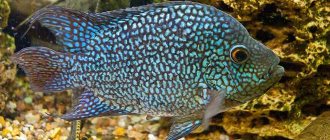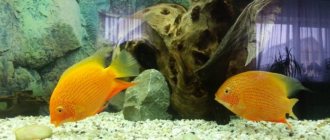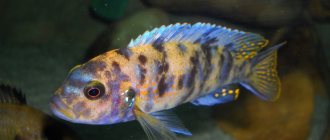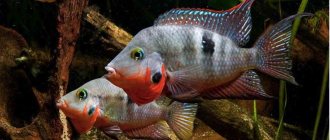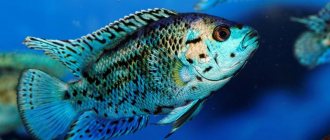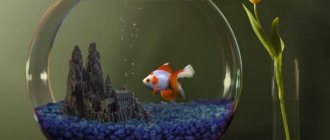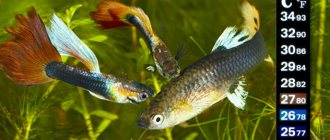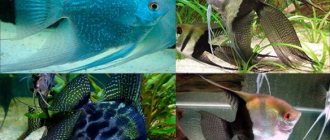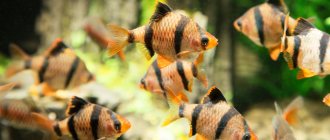General information
Black-striped cichlasoma, also called Zebra cichlasoma, was brought from Central America more than 100 years ago. This is the very first cichlid that was bred at home. The centuries-old history of breeding has not in any way diminished the interest of aquarists in its maintenance.
Black-striped cichlasoma is a territorial fish. This point should be taken into account when moving neighbors to her. Cases have been recorded when cichlazoma, during spawning, attacked fish that were much larger in size than itself. But this is only during the spawning period. With the right selection of neighbors, such clashes should not occur.
Black-striped cichlazoma is one of the smallest representatives of its group
What is special about the content?
The fish's character is quarrelsome and cocky. She can even attack companions larger than herself if she senses encroachments on “her part of the aquarium.” Such possessive characteristics are characteristic of cichlids, but they are especially developed in cichlids.
Because of these qualities, you should not try to establish friendship between them and the more peaceful inhabitants of the aquarium, unless you select species that live in the upper layers of the water.
Cichlazomas cannot live in a small amount of water: they need space, clean water, aeration and mobility of water layers. Care is not difficult, but requires care.
For a pair of young individuals, at least 100 liters of water are needed, for those who have entered the sexually mature phase - at least 250 liters.
Such aquarium inhabitants are characterized by an increased ability to “pollute the reservoir.” Therefore, the presence of a powerful filter in the system is mandatory.
The microclimate parameters in a water house are not as important as for some other fish. Permissible temperature fluctuations are from 24 to 28 ° C, acidity - from 6 to 8. There are also no special complaints about the hardness of the water used.
Appearance
The difference between the black-striped cichlazoma fish and other cichlazoma species is expressed in its small body size. When kept in aquariums, they rarely grow more than 10 cm. Males can boast larger body sizes than females. Their body is more elongated and compressed at the sides. The head is large, the eyes are large, and the lips are thick. The fins are transparent or have a yellow tint; in males, the anal and dorsal fins are pointed.
Black-striped cichlazomas with a grayish-blue body color are common. There are 8 black transverse stripes on each side. It was they who served as the decisive factor in determining the name of the species. In addition to Zebras, Albinos also go on sale.
Maintenance and care, arrangement of the aquarium
The minimum size of an aquarium for one pair of fish starts from 100 liters. In the design, the main emphasis will remain on shelters. They can be in the form of a pile of stones, snags, intertwined branches and tree roots. Ceramic pots will serve as an excellent imitation of a cave. There is no need for live plants, since the fish will most likely quickly pull them out. Other conditions of detention, such as the hydrochemical composition of water, temperature, light level, etc., are not so critical and have wide permissible values.
Photo
In the photo of the black-striped cichlazoma, the distinctive features of the species are clearly visible - transverse black stripes.
The website contains a number of photographs showing different species.
Other types
Striped fish have long been a favorite of aquarists. In addition to black-striped cichlazoma, many hybrid forms are known. Artificial species are created by breeders. There are also natural mutations.
Cichlazomas Black-striped Flamingos
Flamingo cichlazomas, in comparison with the natural species, have a completely different color. Their body can be pale pink, crimson and with a reddish tint. To date, controversy has not subsided over how the Flamingo cichlid originated. Some argue that this species appeared as a result of a gene mutation, while others defend a different point of view and are confident that the pink Flamingo appeared as a result of breeding work.
Flamingo fish have small body sizes - only 7 cm. Females are not as brightly colored as males, but during spawning you can see beautiful iridescent sparkles on the sides.
When breeding, the Flamingo passes on its permanent characteristics to the fry: color and body shape. The species is characterized by stable immunity. Fish are also less susceptible to diseases, provided they are kept properly.
Flamingo cichlid is also called the pink flamingo cichlid.
Albino forms of Black-striped Cichlases
The appearance of Albino cichlazoma is due to a random mutation. The albino form can appear in the offspring of any couple. They are found both in natural and artificial conditions.
On a note!
The body color of Albino cichlazoma is almost colorless. Fish have weak immunity, so they are susceptible to diseases.
Representatives of the gene anomaly are more demanding, so the aquarist must provide certain conditions of detention: water parameters, the same temperature. If the temperature drops below +22°C, the fish may die.
Albino can appear in the offspring of any Zebra-Cichlaz pair
Disc Black-striped Cichlazomas
The variety appeared as a result of selection. Scientists have crossed natural species with closely related ones.
Disc isomorphs have a shorter body, the shape of which resembles a disc. In appearance, they can be confused with false discus. Fish can boast of strong immunity. You can find black-striped disc cichlases in different colors.
Disc Black-striped cichlasomas are fish with a shorter body resembling a disc
Yellow Black-striped Cichlazomas
The variety is very brightly colored. There are clearly visible black stripes running along the yellow body.
Aquarists dubbed them “Lemons”, and all thanks to their juicy color.
The size and body shape of yellow cichlases are the same as those of the natural species. However, when breeding, it should be taken into account that this variety is more capricious and very sensitive to flaws in the conditions of detention.
Due to their expressive bright and sunny coloration, these fish are often called Lemons
Habitat
In 1867, the first individuals of black-striped cichlid were described. In 1927, the fish spread throughout Europe. The homeland of this exotic underwater resident is Central America. In the 21st century it was discovered in the southern states of the USA.
Black-striped cichlasoma prefers to swim in small or large rivers with fast currents, preferably with a rocky bottom. Such natural conditions allow the fish to find shelter from enemies. Open spaces are not for cichlids. The diet of natural species includes larvae, worms, insects, and plants. In nature, the average life expectancy is 10 years.
Description
| Kingdom | Animals |
| Type | Chordata |
| Class | Ray-finned fish |
| Squad | Perciformes |
| Family | Cichlids |
| Genus | Cichlids |
They belong to the order Perciformes, suborder Perciformes, family Cichlidae.
Appearance
Black-striped cichlids are small fish that rarely grow more than 9 cm in captivity. They have a tall body, elongated in length and narrow in width. The color is blue with a purple tint, about 8 black stripes run across the body. The female has small orange spots on her abdomen.
Kinds
Cichlids are a large family of fish that includes more than ten species.
Meeka : has a more rounded and high back.
Diamond : has fewer stripes (up to 6) and a paler color.
Severum : grows up to 20 cm in length. It has an expressive red eye shell.
Managua : the largest of this family (up to 40 cm). There are no stripes. The color is spotted.
Eliot : distinguished by a bright burgundy belly. The body is yellow with orange tints.
Salvini : green to brown in color. A thick black stripe runs down the middle of the body.
Habitat in nature
The homeland of the black-striped cichlid is the waters of South America. Most often found in Panama, Chile, Brazil, and Honduras. They were later introduced to Australia, where they formed a stable population. They feel comfortable in rivers with a calm current, in lakes and ponds with a rocky bottom.
Care and maintenance
An important point that is worth paying attention to is the territoriality of cichlases. This is why difficulties arise with selecting neighbors and decorating the aquarium. The content of Flamingo cichlizoma differs significantly from the natural species. Before buying a pet, it is recommended to study information on how to properly care for them.
Aquarium
A couple of black-striped cichlases must be placed in an aquarium with a volume of at least 100 liters. Adult cichlids in an aquarium will require a volume of 250 liters. Such a huge tank will be needed if it contains several varieties of cichlids. In a species aquarium, 60 liters of water per couple will be enough.
Water parameters
Aquarium cichlids, when properly kept, can live up to 15 years in captivity. Their immunity is so strong that they rarely get sick. To create optimal conditions for them, you need to look at the temperature of the water in the aquarium, the indicator of hardness and acidity:
- water temperature should be +20-27°C;
- acidity – 7-8 pH;
- hardness – 8-30 dH.
Filtration and aeration equipment will only need to be installed in a large aquarium. In a tank with a large number of fish, installing a filter and compressor is a must. In a small aquarium, special equipment may not be installed.
Important!
When purchasing a filter, special attention should be paid to its power. The optimal power of the equipment is its ability to pass 2 volumes of water through itself in 1 hour.
It is recommended to perform a 30% water change every week.
Even a novice aquarist can keep black-striped cichlazoma.
Plants
With the help of plants, you can divide the aquarium into zones. The bottom must be rocky. If you do not cover the root system, all the plants will be immediately dug out of the ground by little cichlid cichlids.
Aquarium plants with strong roots:
- crinum;
- Echinodorus;
- Anubias;
- cryptocoryne;
- Vallisneria.
Black-striped cichlids do not have a vital need for plants, so greens do not need to be planted. Especially considering the fact that the fish will most likely remove them from the ground.
To somehow decorate the aquarium, you can buy greens: duckweed, pistia, riccia, wolfia. Algae will not only shade and attract the eye, but will also be a good herbal supplement to the diet.
Priming
In their natural habitat, black-striped cichlids are found in reservoirs with rocky bottoms. Therefore, granite chips or small pebbles should be placed on the bottom of the aquarium. Cichlids love to swarm in the substrate, so they will arrange the pebbles as they please. It is for this reason that the water often becomes cloudy.
Covers should be placed at the bottom of the aquarium. They will also use the decorative function:
- grotto;
- snag;
- cave;
- large stones;
- coconut shells.
Cichlids need shelter. You can build slides from stones, put a large shell or half a coconut shell, or put a small flower pot.
Note!
Each pair of fish occupies a certain corner in the aquarium. This place must be limited, otherwise the males will constantly fight. Plants can be used as a natural limitation.
Every week it is necessary to update the water in the aquarium by 25-30%.
Equipment
To keep black-striped cichlids you will need a set of equipment:
- External or internal filter. It is better to buy an external one, as it is more powerful and purifies the water better. One minus is the price.
- Thermometer. Experienced aquarists advise buying an internal thermometer. It shows the water temperature more accurately than a sticker thermometer.
- Aerator. A compressor or aquarium pump will do. It is advisable that the aeration and filtration function be displayed by various devices.
- Heater. Temperatures below +22°C are simply destructive for some species. A heater is necessary in autumn and winter.
All of the above devices must be in the aquarium. Their availability and quality determine how successful the breeding of black-striped cichlids or their varieties will be.
Lighting
One single parameter that does not play a special role. You can buy plant lights or LEDs to highlight the colors of the fish.
Reproduction of black-striped cichlases
Any aquarist knows what the zebra cichlid looks like.
These exotic inhabitants have achieved enormous popularity, not taking advantage of their unique color, but also due to behavioral characteristics that are absolutely not typical for most lake fish, not taking into account similar cichlids.
These aquatic inhabitants, for example, are recognized as excellent producers who, like most fish from the cichlid group, know how to take care of their children. But what to do if an aquarium lover decides to start breeding black-striped cichlid for the first time, and does not understand how to take the initial steps, and what conditions they need for successful spawning?
If an aquarist is interested in such topics, in the article he will understand many answers to questions that have arisen on this topic.
Thus, to successfully breed black-striped cichlids, an amateur needs to purchase a married pair of breeders, as well as an aquarium pond with an established nitrogen cycle, an aerator and a filter device.
In fact, fry of black-striped cichlases is so simple that the presence of a reservoir for breeding and the quality characteristics of the aquatic environment are absolutely not important, but still, of course, extremes should be avoided.
Feeding
When breeding cichlids at home, you should know that this species is not picky about food. Striped fish prefer live and frozen food:
- bloodworm;
- Artemia nauplius;
- tubifex;
- Daphnia.
But the diet should not consist of only animal food. 1/3 of the diet can be allocated to plant foods. Cichlids love cucumbers and zucchini - they need to be cut into small pieces, as well as dandelion leaves, lettuce, nettles, and duckweed.
Striped fish should be fed 2 times a day! Portions should be small, as black-striped cichlids have an excellent appetite, which often leads to overeating. A fasting day is required once every 7 days. All this applies to adults. The fry should eat 6 times a day.
Fish are omnivores, so sometimes they can be pampered with minced meat, pearl barley and oatmeal, and seafood. After such feeding, the water becomes cloudy and dirty. Therefore, you cannot sprinkle a lot of such food. After feeding, be sure to turn on the filter to a higher power mode.
If the color of Zebras is bright, iridescent and expressive, it means that the fish eat balanced food.
Safe maintenance largely depends on proper nutrition
Compatibility
Only during the mating season do black-striped cichlids behave aggressively; the rest of the time they are quiet and calm.
Compatibility with other fish is only possible in a large aquarium and with proper division of the tank into zones.
Good neighbors include:
- Pelvicachromis;
- diamond cichlases;
- Psedotropheus;
- handsome khromisov.
In addition, with proper arrangement of the tank, barbs, gouramis, parrots, labeos, swordtails and bots can be added to the black-striped cichlids.
Friendship with other inhabitants of the underwater world is possible, but not always. During spawning, females lay eggs in stones and actively protect them. Therefore, quarrels are not excluded. If cichlids are placed in another aquarium for spawning, then such coexistence will be peaceful.
Cichlazomas do not like loneliness at all. Swimming around the aquarium, the only fish will have no one to quarrel with. You should know that black-striped cichlids do not live long alone. Therefore, in order to create comfortable conditions for the fish, at least a couple should be introduced into the aquarium.
Attention!
When purchasing striped pets, it is important to take into account the fact that for every male there should be one female.
For the temperamental blackband cichlids, fish such as guppies, mollies and neons are perceived as food. And large species of cichlids can cause trouble for Zebras. For example, the proximity of cichlids to piranhas is unacceptable; the latter will emerge victorious in a quarrel.
Black-striped cichlasoma does not get along with large and aggressive fish
Content
This type of aquarium fish is very easy to care for. The difficulty may lie in the fact that cichlases do not get along well with other inhabitants of the common aquarium. Therefore, preference is given to a separate aquarium, or keeping blackstripes together with other South American cichlids in a large aquarium.
Nutrition
Zebra cichlids are unpretentious even in food, being omnivores. They will eat whatever you offer: plant-based tablets, artificial food for cichlids, spirulina flakes, vegetables. It is better to feed the fish twice a day in small portions so that the aquarium is not contaminated with food residues.
Care and living at home
It is better to keep cichlases in large aquariums, where there is room for free swimming. For example, a pair of young cichlases can be kept in aquariums with a volume of 100 liters, but individuals that have reached sexual maturity will need a larger aquarium - at least 250 liters. These fish live comfortably in a container with clean water and a moderate current. This can be achieved with the help of a strong external filter, which will also be useful because there is quite a lot of waste from this fish.
Black-striped cichlazomas prefer warm water within 24-28°C, but the hardness and acidity parameters may vary, but it is better to stick to the following pH range: 6.0-8.0, and 6-8 dGH.
These aquarium fish are rightfully considered unpretentious and very easy to care for. It is enough to provide the aquarium with sandy soil, stones, driftwood, and the black-striped cichlid will feel comfortable. You can introduce variety with the help of plants by planting an unpretentious and strong species, since fish often dig into the soil, and in doing so can damage the roots of plants. Digging is a common occurrence for this species of fish, but it can also indicate that spawning time is approaching.
Compatibility with other fish species
Cichlazoma is a conflict fish, so it is better to keep it alone or in the company of other cichlids. Keeping this fish in a common aquarium with calm or large fish can lead to the death of the former, or to the death of the cichlazoma itself in a clash with a large fish.
The aggressiveness of cichlases is especially pronounced during the spawning period. During this period, they can inflict fatal wounds on almost any fish they come across. There have been cases of death of Oscars or plecostomuses from the action of cichlases, despite the fact that the victims were several times larger.
The ideal keeping option is in pairs, one male and one female. Black-striped cichlazomas often do not favor even representatives of their own species.
How to distinguish a male from a female.
The male cichlazoma differs from the female in several ways:
- Noticeably larger than the female;
- Steeper forehead;
- Less pronounced color;
- Sharp and elongated dorsal and anal fins.
The female differs from the male in its smaller size, rounded shape, and its abdominal area is orange in color.
Reproduction and breeding
Reproduction of black-striped cichlases does not cause difficulties. Aquarists even came up with a joke that cichlid reproduction and spawning can happen right in the bag while you are carrying them home from the store. In order not to miss how cichlids reproduce and to avoid clashes with neighbors, it is recommended to place them in a spawning aquarium in advance. Some aquarists separate cichlids from other fish with plexiglass with holes made in it, leaving 1/3 of the tank for the Zebras.
How to distinguish a female from a male
The male and female have pronounced differences:
- the male is 5 cm larger than the female;
- black-striped males have a duller plumage than females;
- males have a fatty bump on the forehead;
- Males have pointed fins and small spots on the body.
In females preparing for spawning, the abdomen turns orange.
How does spawning work?
Black-striped cichlazomas reach sexual maturity at 8-9 months. They can reproduce throughout the year. For spawning, it is advisable to place them in a spawning tank.
To stimulate spawning, it is necessary to frequently change the water and gradually increase the temperature to +29°C. The courtship period lasts quite a long time. The male does everything possible to get the female to pay attention to him. He constantly swims in front of her and flirts with her.
You can tell that cichlids are ready to spawn by the fact that they are starting to prepare a place for laying. Zebras dig up the soil, make holes, or use decorative elements. One female can lay 300 to 400 eggs. Having laid eggs, the female is next to her and waves her fins, and the male stands guard and protects the future offspring.
From time to time, the female reviews all the eggs and removes dead and unfertilized eggs from the clutch.
The fry appear on the 3rd day. During the first days they feed from the yolk sac. During this time, they grow up and are ready to swim and eat on their own.
Note!
At this time, the male may become too aggressive and eat all the fry. His behavior must be observed. At the first signs of aggression, it should be removed from the spawning tank.
The color of the female zebra cichlid is brighter, however, the males are larger than them
How to care for young animals
The fry are very friendly fish; they always stay together and do not swim far from their parents. At night they sleep in a “shelter nest”, and the female covers them with her body. You cannot separate the fry from their parents too early. The male and female will become stressed and act too aggressively.
Young animals can be fed:
- Naupia Artemia;
- cyclops;
- Daphnia;
- special food for fry;
- chopped food for adults.
Once the fry are 3 weeks old, they will be large enough to feed on the adult blackband cichlass food.
In an aquarium with kids, the presence of a filter is a must!
After the fry grow up, it is necessary to think about their future fate. If you keep it for yourself, the aquarium may become monospecies. Not only will it be impossible to purchase other species, but there won’t be enough space for your fish. Some aquarists give the offspring to friends, some sell them as cichlases.
How long do they live?
Life expectancy depends on the conditions of detention. In an aquarium, a Zebra can live up to 15 years. Fish have strong immunity, so they rarely get sick.
Life expectancy is reduced if fish are kept alone. They must be kept in pairs.
It is very interesting to watch the mating games of the Black-striped cichlazoma
Reproduction
Many aquarium fish breeders practiced on the black-striped cichlasoma, because it does not require special conditions for reproduction. There is a high survival rate among the offspring because cichlids are very good parents.
Like other American cichlids, the zebra is monogamous. Pairs form at a young age, so it is better to take a school of young fish and raise them together.
In order to obtain young animals, you need to select sexually mature individuals of different sexes. Sexual dimorphism in black-striped cichlases is very pronounced, so determining the sex of a fish is not difficult:
- Females are smaller than males, they have smooth, streamlined shapes, a bright, distinct pattern, a red-orange spot on the abdomen and an ovipositor at the anus.
- The males are large, with a massive, fleshy body, a large, convex forehead and pale, blurry stripes.
A male without orange spots and with a fatty growth on his forehead.The female is more slender, and has an orange coating on her abdomen.
If there are other fish living in the aquarium, then it is better to place a couple in a separate spawning tank to reduce stress levels and increase the survival rate of the offspring.
A small cave or large, smooth stones are suitable for the substrate. If they are not there, the cichlid will still find a suitable place to lay eggs.
To stimulate spawning you need:
- make daily changes 1/5-1/4;
- raise the water temperature to 28-29 ⁰С;
- increase the proportion of high-protein feeds in the diet.
Once the pair is ready to breed, the male will begin to perform his mating dance. After courtship, the female lays eggs, and the male fertilizes them. The fertility of a female, depending on age, can reach up to 300 eggs.
After spawning, parents begin raising their offspring:
- The female periodically cleans the eggs, removes dead, unfertilized eggs, and washes the clutch with her fins.
- The male stands up to protect the offspring, violently driving other inhabitants of the aquarium away from the eggs. Sometimes he can be too aggressive, in which case he is removed, leaving the female alone with the clutch.
Hatching of the larvae begins 48-72 hours after the start of incubation.
After 2-3 days, when the yolk sac resolves, the fry come out of hiding. The female carefully monitors the walking of the offspring, before going to bed or in case of danger, driving the fry to a safe place. At this time, she helps them feed, raising mud from the bottom with sharp movements of her fins. The female bites into large pieces of food and spits them out for her babies.
In order for the juveniles to grow faster, it is recommended to feed them. The following are used as starter feed:
- powdered dry food;
- chopped egg yolk;
- “live dust” (grown ciliates);
- decapsulated brine shrimp eggs.
You can give minced meat from live food to the fry, you just need to make sure of their quality.
Fry are very sensitive to water parameters, so regular water changes (1/3 twice a week) and good aeration are required.
After 3-4 weeks, the juveniles will begin to feed on food for adult fish, so they need to be transferred from their parents, otherwise they may be eaten.
Diseases and prevention
Nature has endowed black-striped cichlases with strong immunity, but in unsanitary conditions, even such a strong barrier cannot prevent diseases.
Ichthyophthiriasis or semolina is the most common disease among cichlids. Dirty water affects the development of the disease.
Aquarists called the disease semolina, since the whole body of the fish seems to be powdered with white pellets and lumps, reminiscent of semolina. From these tubercles emerges the equiciliated ciliate, the causative agent of the disease.
By multiplying in the fish’s body, ciliates lead to exhaustion of the pet. Timely measures taken can save the life of a resident of the underwater world. Once the form is advanced, nothing can be done to help the fish.
The disease has an incubation period. Its duration is 7-14 days. At this time, the fish’s condition worsens significantly: it becomes lethargic, itches on its sides on the ground, as it is plagued by an intolerable itch. As soon as the aquarist notices one grain of white plaque, it is important to begin treatment immediately, otherwise the fish may not be saved.
Fighting ichthyophthyriasis is not difficult. At first, it is necessary to gradually increase the temperature in the tank to +32°C. Such a high temperature will kill the parasitic ciliate and the fish will begin to recover. It is recommended to pay close attention to the operation of the filter during the fight against the disease.
If time is lost, what can be done to help cichlazoma. There are 2 effective methods:
- Baths with salt. Prepare a 5% saline solution and keep the striped fish in this solution 3 times a day until they recover.
- Salt can be added directly to the aquarium. For 10 liters of water - no more than 2 tbsp. l. While this method will benefit cichlid fish, it will be disastrous for barbs and catfish. Therefore, before adding salt to the tank, other inhabitants of the aquarium will have to be removed.
Pet stores sell special medications designed to treat ichthyophthyriasis. The products are dissolved in water according to the instructions.
Fish diseases:
- Hypoxia. A lack of oxygen is observed in a small aquarium if the number of fish in it does not correspond to its volume. In addition, aeration does not work well.
- Ammonia poisoning. Regular water changes and general cleaning of the aquarium with a complete water change will prevent the fish from getting poisoned.
- Cotton disease. If striped fish have a weakened immune system, lumps that look like cotton wool appear on their body.
- Tuberculosis. The disease is incurable - the fish die.
Advice!
To prevent illness, it is recommended to follow preventive measures: maintain optimal water parameters, clean the tank, feed the fish with good food. In this case, the fish will always be healthy.
The most common problem for zebra fish is ichthyophthyriosis.
Adviсe
By listening to advice from experienced aquarists, you can avoid mistakes in caring for black-striped cichlids.
- The purchase of an aquarium should take into account the future size of the pets. If a tank with a volume of 60 liters is sufficient for one pair, then for flock keeping you will need an aquarium of at least 300 liters.
- To place a tank with Zebra cichlids, a special stand is required. The aquarium for keeping the species is quite large, so the cabinet may crack under its weight.
- When bringing fish home in a bag, you need to give your pets time to adapt. To do this, place the bag of fish in the aquarium and wait until the temperature equalizes. This usually happens within half an hour. Then you need to open the bag and gradually pour aquarium water into it.
- To prevent digging up the aquarium soil and digging up plants, the owner must prepare bottom decor for the fish in advance. It is recommended to install grottoes and caves so that underwater inhabitants do not show their building instinct and dig everything upside down.
- Every week it is recommended to change the water in the aquarium by 1/3 of the volume. New water must be settled.
- If plants are planted in the tank, then they need good lighting, otherwise representatives of the flora will stretch towards the light source.
- An aquarium for black stripes must be zoned. The tank must have a secluded place where the fish can rest quietly, and a “nursery” where they can lay eggs and care for small offspring.
- Side or front lighting will enhance the color of the fish. It is advisable that the lighting be installed from above.
- Before purchasing a new food, it is important to find out information about the manufacturer and read reviews. You cannot buy feed in bulk.
- You cannot separate pairs of striped fish and destroy their spawning area. Cichlazomas create strong pairs for life, and the spawning site must be permanent.
Black-striped cichlasoma are a long-lived aquarium fish and can live more than 10-15 years
A notable feature of Zebra aquarium cichlases is that they remember the owner’s face. When the fish get used to their feeder, you can even pet them and feed them by hand. But if the striped pet doesn’t like something, the underwater inhabitant may bite.
Reviews
In different bodies of water, black-striped cichlids behave differently and exhibit a specific character. Aquarists have noticed that the brightness of the body color changes depending on the saturation of the lighting. Having created the necessary conditions for black-striped cichlases, there will be no difficulties in keeping them. Gray fish with black stripes need to maintain a constant temperature and a balanced diet. The common tank must have a filtration and aeration system.
Would you like to purchase a Blackstripe Cichlid for your own aquarium? Share in the comments!
